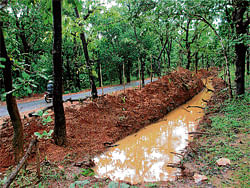
Farmers of Uttara Kannada district’s Kalave have set a great example when it comes to conservation of water. They have dug many percolation pits and tanks across the region. Consequently, groundwater levels have improved drastically, reports Sandhya Hegde Almane.
The onset of the monsoon enhances Malnad’s beauty. Though a tad delayed, it did keep its date with the region this August. It is a treat to see Malnad’s many water bodies brimming with clear water. The story is not the same throughout Malnad region.
Take Kalave village in Uttara Kannada district. This village in Sirsi taluk is located in a hilly region and rainwater flows downhill. The problem of water paucity is cause for concern among Kalave’s residents. This, in spite of the region receiving adequate rain.
As a solution to this crisis, local farmers hit upon the idea of digging percolation pits to save rainwater. Thanks to their conservation efforts, Kalave residents have, over the past few years, been using this water during summer. This attempt by farmers turned out to be a success, thanks to grants from Kalave’s village forest committee in 2006.
The region has now begun to see a rich overgrowth of grasses. The fertility of the soil has also improved. Arecanut farms, which were earlier withering away, are now flourishing. The efforts of farmers who dug pits and ensured adequate water supply are now showing.
The village forest committee dug pits on 125 acres of forest land with the assistance of the Forest Department. In the summer of 2011, earthmovers were used to dig pits with a capacity to save 8,000 to 12,000 litres of water. This has stopped rainwater run-off near Haranahalli, Keregadde and Handijaddi hamlets. The trenches that farmers have dug on the borders of their fields not only prevent cattle from straying into farm lands, but also save water.
Also there has been a significant increase in the ground water level. As a result, pumping of water by way of electric pumpsets is not required in Haranahalli.
Sreedhara Bhat and Narasimha Dixit, residents of Haranahalli, beam with pride about the achievements of their people, as they explain the benefits derived from these percolation pits.
Farmers’ initiatives
While the project to conserve water was implemented with the help of funds from the village forest committee, there’s another story behind how the village got its road.
After years of struggle, a road was sanctioned to the region under the Prime Minister’s Gram Sadak Yojana.
But to lay a road, there was need for 8,600 truck loads of soil. Kalave’s farmers then hit upon the idea of building tanks in the forest and using the soil to construct roads. Thus the village not only got five tanks to conserve water, but also got a seven-kilometer-road without spending a paisa. These tanks can store nearly 1.8 crore litres of water. The tanks are interlinked, so once one of them is full, water flows into the next tank.
Other success stories
Apart from rainwater harvesting, Kalave has seen success on the forestry front as well. In place of acacia that dominates lots of farm lands, the region has plenty of fruit-bearing plants. Acacia is only used as a fence in areas bordering the hill and inside this fence, nearly 25 types of trees including jackfruit, mango and jamun are grown.
This village has 18 tanks that help people in the region combat drought. Every summer, at least two tanks are dug, ensuring that the village does not face water shortage even in summer.
This village can teach us many nuances of water conservation. Shivananda Kalave, an environmentalist, points out that anyone who is keen on learning about the importance of water conservation, should visit Kalave.
(Translated by Bhumika Rajan)
Deccan Herald is on WhatsApp Channels| Join now for Breaking News & Editor's Picks